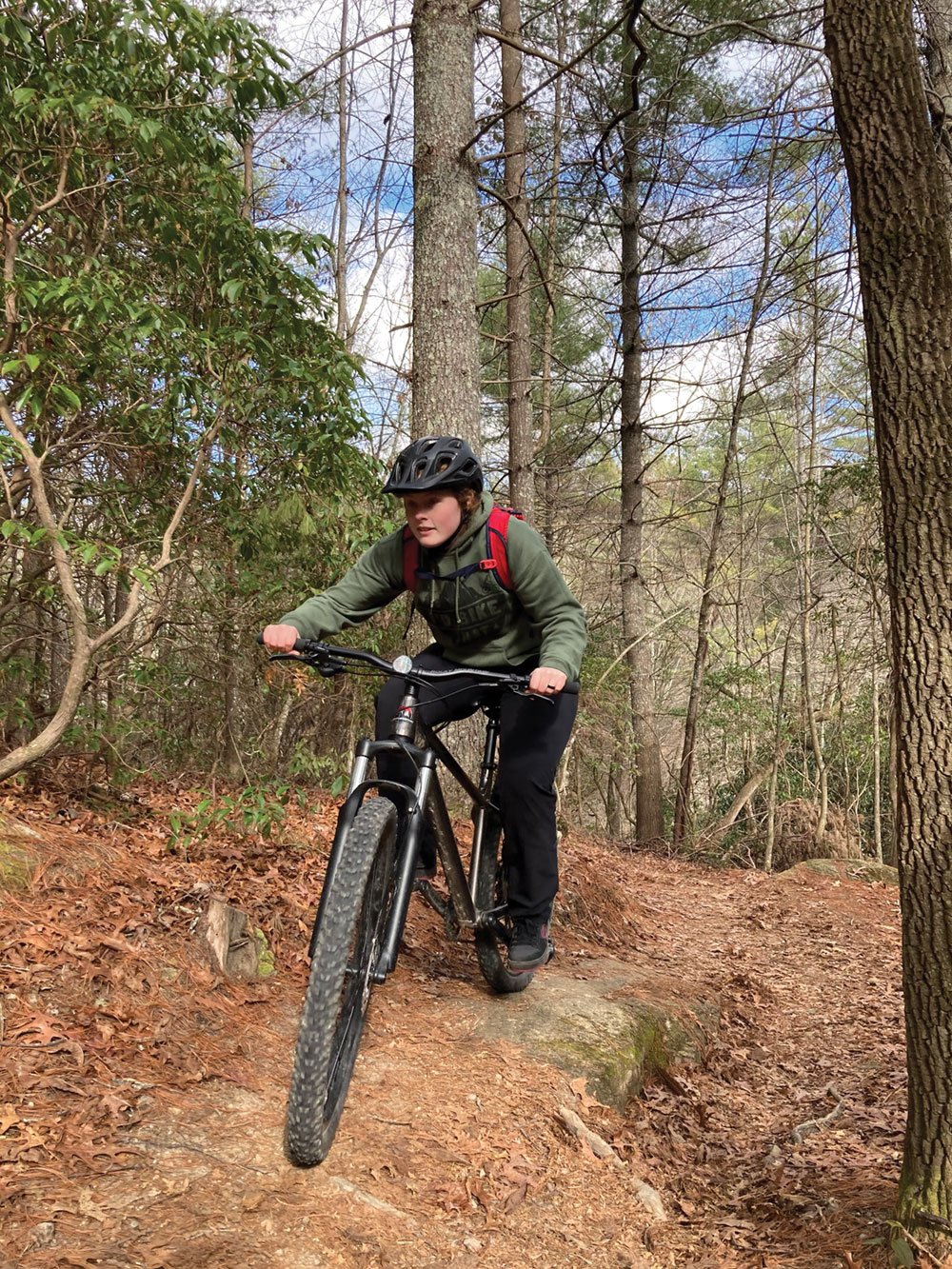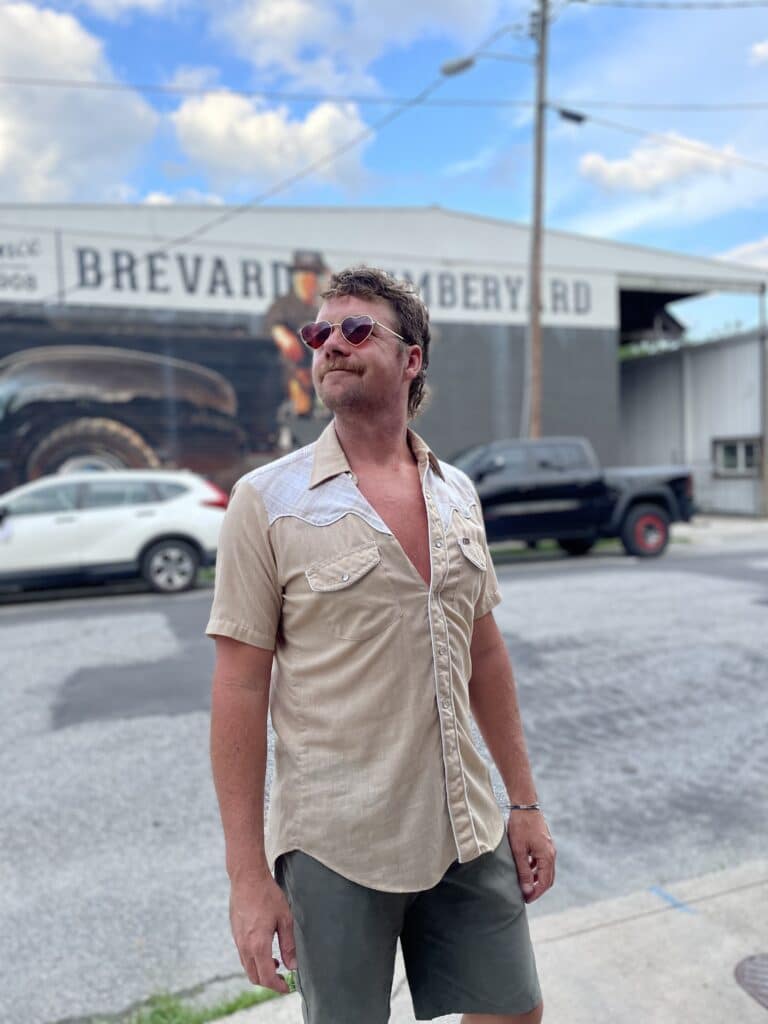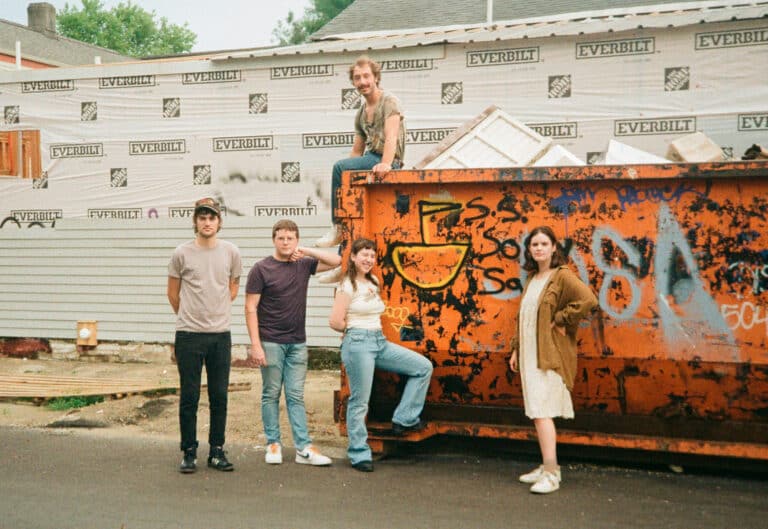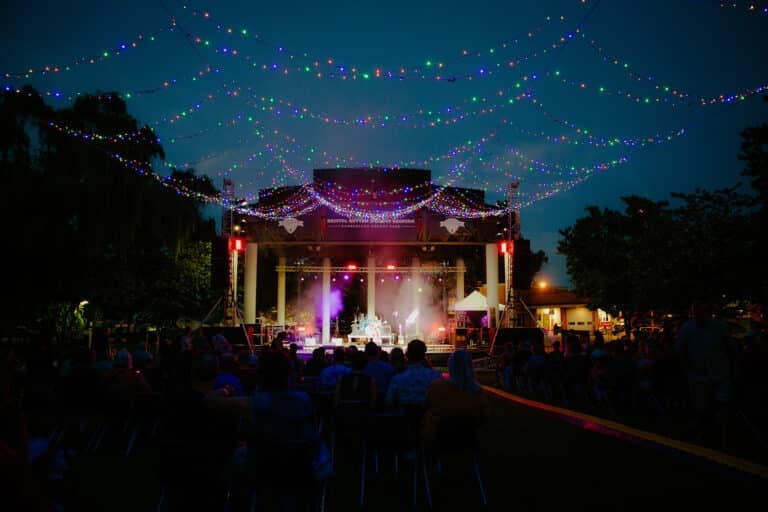Pitch pine roots grab my front tire like the wet, wanting fingers of some woodland monster. The whole bike stutters, for a few seconds caught in the beast’s slick embrace, before inching uphill. A switchback scabbed with granite looms, and I shift down to quiet the white-hot pain flickering in my legs. I live in the granny gear. I have no shame.
At 5’7″ and 185 pounds, my interpretation of mountain biking is unabashedly labored. I lack the V02 max and bulging, ogle-worthy quadriceps of my singletrack counterparts. I show up to Brevard’s rowdiest trails in size 12 hiking pants and a flea market T-shirt, a discounted hardtail stuffed not so elegantly in my van. (To seasoned riders, this is like bringing a dull spork to a gunfight.) I then start a crawling ascent, pit-stopping in the bramble to let other bikers pedal ahead.
I have never been fast. In first grade, I weighed 105 pounds—more than twice that of my classmates. I was asthmatic, ruddy-faced, and quiet. My gym teacher at the time, a pot-bellied man with a gray braid down to his waist, thought it was a good idea to have us kids run laps in single file. There were two rules to this Draconian exercise: no passing and no walking. So, when a tinny Gwen Stefani blasted from the boombox, I willed my body to move and to move fast. But my legs soon cramped and the procession of six-year-olds bottlenecked. Little boys sneered, goading me to quicken my shuffle.
By ninth grade, I had ballooned up to 240 pounds. My weight yo-yoed from there—20 pounds lost, 35 pounds gained, 50 pounds lost, 80 pounds gained. When I moved back to my sleepy-eyed hometown after college, I weighed 278 pounds. I wore size 24 pants to my first job interview.
But I saw my future when I returned home. My mom, always a heavyset woman, felt a tightness in her chest one day. She drove herself to the hospital where doctors found blood clots in her lungs. Her health moldered quickly after that. Specialists kept spewing off prognoses: pulmonary hypertension, cardiomyopathy, renal failure, endometrial cancer. At 54, she could barely walk to the bathroom. Disease anchored her to an unmade bed.
My mother’s immobility stirred up a sleeping giant—my primal need to move. And biking, for whatever reason, seemed the easiest way to do that. Maybe it’s because pedaling is made out to be so natural. Just like riding a bike. Maybe it’s also because the rabbit hole of YouTube had directed me to a shaky, five-minute clip of bikers gliding down the absolute gnar of Pisgah’s Farlow Gap. Just like riding a bike.
Impressed and overconfident, I bought my first hardtail from an 80-year-old lady named Casper. If Casper thought it odd for a nearly 300-pound woman to buy her rusted Trek with a faded “Bike Punk” decal, she showed no signs of it. A dainty cloud of essential oils, she floated into her garage for a hex key, raised the seat, and sent me on my way. I instantly careened down a beginner’s trail on the Henderson County side of DuPont Recreational Forest, slamming face-first into a tree. A limb left a bloody kiss on my neck. Rocks purpled my shins. The handlebars tweaked my wrist. It was awesome.
The next two years were a blur of rock gardens and hip jumps. Besides a short transition period between Casper’s hand-me-down—a spooky hunk of metal that left me bruised and limping—and my current Rocky Mountain, I have hit some kind of trail every weekend. Even when COVID-19 shut down public lands, I piecemealed a 15-mile loop through downtown Hendersonville. Gravel grinds, breezy downhills, speed bumps for air. Those few hundred escapades revealed a community that could care less what you weigh, though I lost almost 100 pounds by joining it. A few months after I started riding, I found myself chugging up the final leg of Ridgeline Trail, a six-mile loop in DuPont that finishes with a famously flowy descent. I wheezed like the Big Bad Wolf, my tires moving five feet backward with each pedal stroke, or so it seemed. As I was about to spit out some colorful language—bikers are the new sailors—a commotion erupted from the picnic shelter overlooking the trail. It took a second to realize that a group of bikers were ballyhooing for me. “Just send it!” screamed one. “Push up that thing!” yelled another. They were genuinely stoked.
After we bombed down the mountain together, one of the riders sidled up to me. “It’s cool to see another female mountain biker. Give me a call whenever you want to hit the trails,” she said. I logged her number in my phone and nodded, a little dumbstruck. When did I become a mountain biker?
Now, I don’t want to give the wrong impression. If the demographics of western North Carolina’s mountain biking community are shifting, they are shifting slowly. Most folks I encounter are skinny-waisted white dudes on astronomically expensive rigs. But there is an unspoken agreement that we all belong—that we’re all out there to send it in whatever way we can. And that is pretty bike punk, if I say so myself.
Cover photo: The author on one of her regular rides in western North Carolina. photo courtesy of the author.








